Definition and Objectives
The organization of the event “Tour De France” implies spectator events, which involves recreational activities, scheduled in conjunction with the annual bicycle competition taking place for three continuous weeks on the roads of France.
The objectives:
- The involvement of the spectators in the sporting activity;
- The creation of recreational activities;
- The organization of sponsorship processes;
- The creation of a distinctive unified theme for the event;
- Linking the event culturally and geographically to the country of origin, as well as the stage countries.
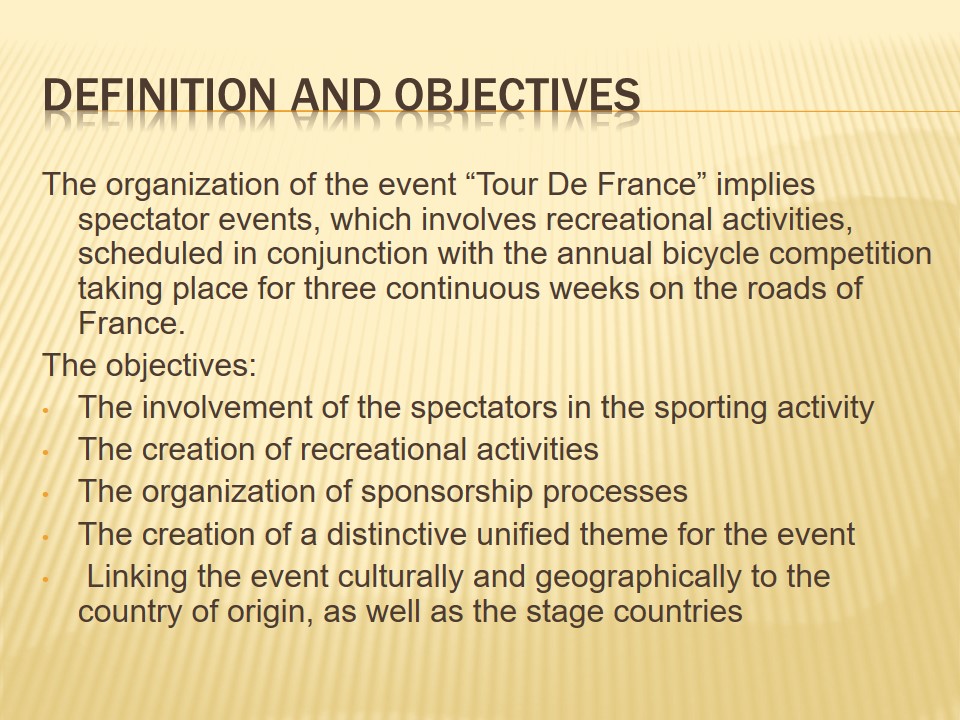
Rationale
- Tour de France is a major event that draws approximately 15 million spectators in a typical year’s race and 4 million TV viewers;
- The numbers of viewers make the event of particular interest to sponsors and partners;
- Powerful publicity generating capabilities;
- The internationalization of the event;
- The attachment of the event to the cultural heritage of France and the race’s accompanying entertainment activities;
- The attachment of the event to sporting activities, performances, personalities, merchandises, and media appearances.

Tour De France
- Content.
- Entertainment.
- Environment.
- Food and Beverage.
- Production.
- Program.
- Theme.
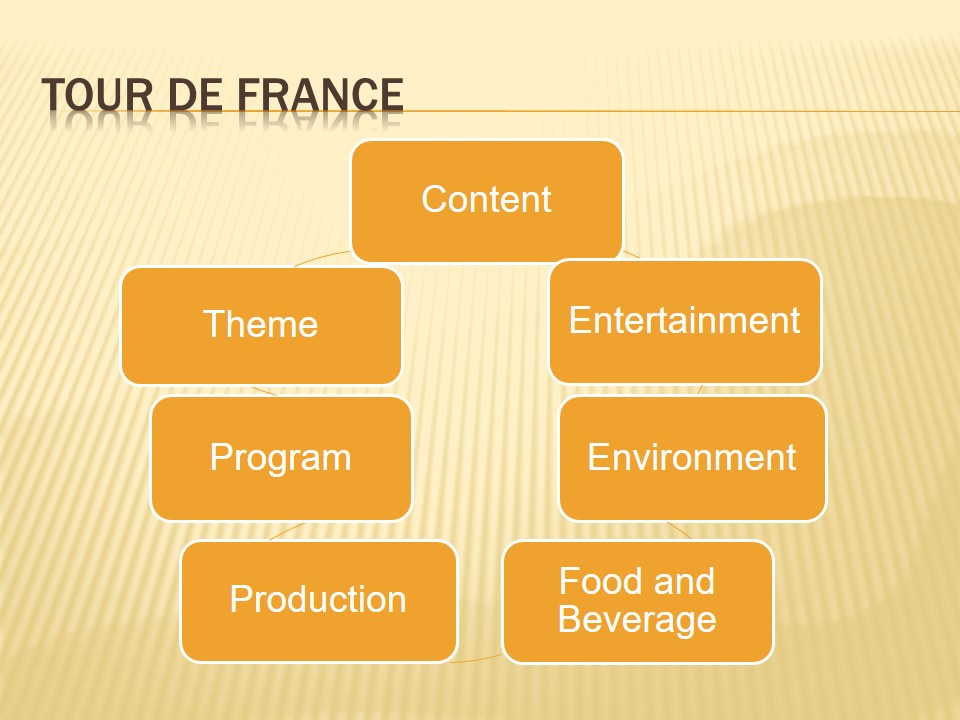
Content
The content of the event is comprised of the following stages:
- The start of the race:
- Entertainment activities (concert, show, and etc), setting the theme of the event and linking the event to the country of origin;
- The start of the race (media coverage) –blogs, forums, polls, lotteries, quizzes, and etc;
- The organization of advertisement elements and sponsors programs (banners, barriers, boards, and etc);
- Establishing the symbol of the event;
- Activities throughout race stages:
- Media coverage;
- Advertisement and sponsor programs;
- Food and beverages;
- Differentiating the stage theme to local symbol or theme;
- The award presentation ceremony:
- Media coverage of the arrival;
- The celebration of the winner (music, flags, fireworks and etc);
- The award ceremony (sponsors’ banners, the award, the photoset procedures, and post race interviews);
- Establishing the area of the ceremony and limiting public access;
- The closure ceremony;
- A concert of world and local celebrities:
- Sponsors’ presentations on stage;
- The winners on stage;
- The show is closed with fireworks and pyrotechnics.
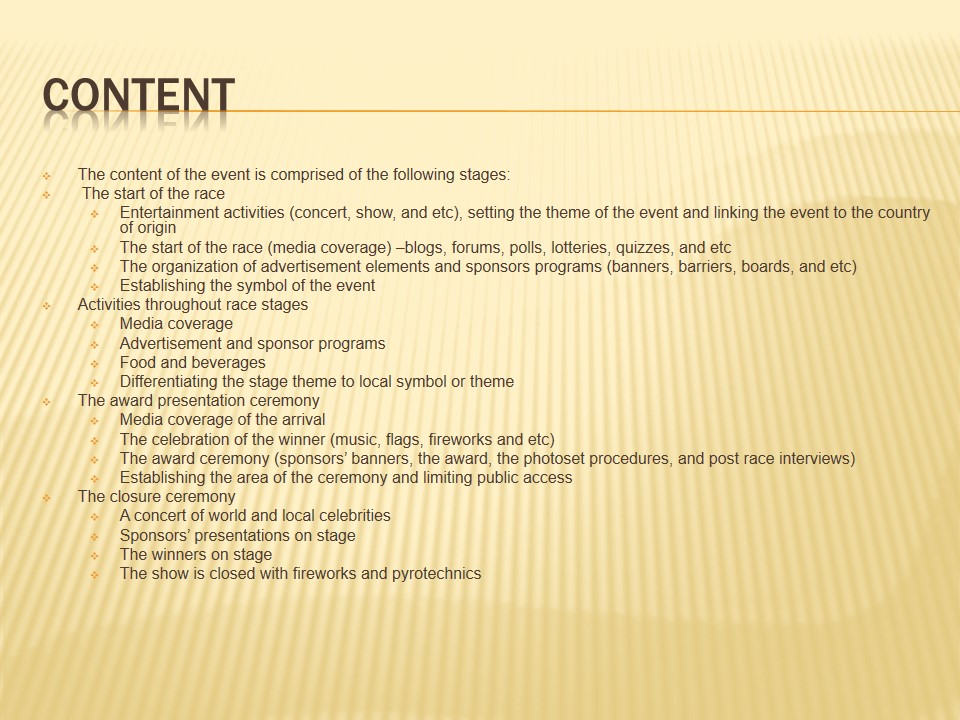

Theme
Event theme:
- The symbol of the competition (e.g. bicycle, bicycle and the Eiffel tower, and etc);
- The main color of the event – yellow or yellow with red;
- Merchandise related to the competition;
- The soundtrack of the Tour.
Destination theme:
- Attributes of France;
- The creation of thematic elements for each of the regional stages;
- Local musical bands and groups in the concerts.

Entertainment
The main focus:
- Opening ceremony;
- Award Ceremony;
- The Closing ceremony;
- Media coverage of the race;
The secondary focus:
- Big screen live coverage of the race stages;
- Organization of merchandise promotion with the symbolic of the race;
- Organization of polls and quizzes;
- Staging local performances at the arrival and the departure of the participants at each stage;
Support activities:
- Organization of tours to each area of the race;
- Local sport competition related to the race, prior to the arrival of the participants (e.g. marathons, freestyle shows and etc).
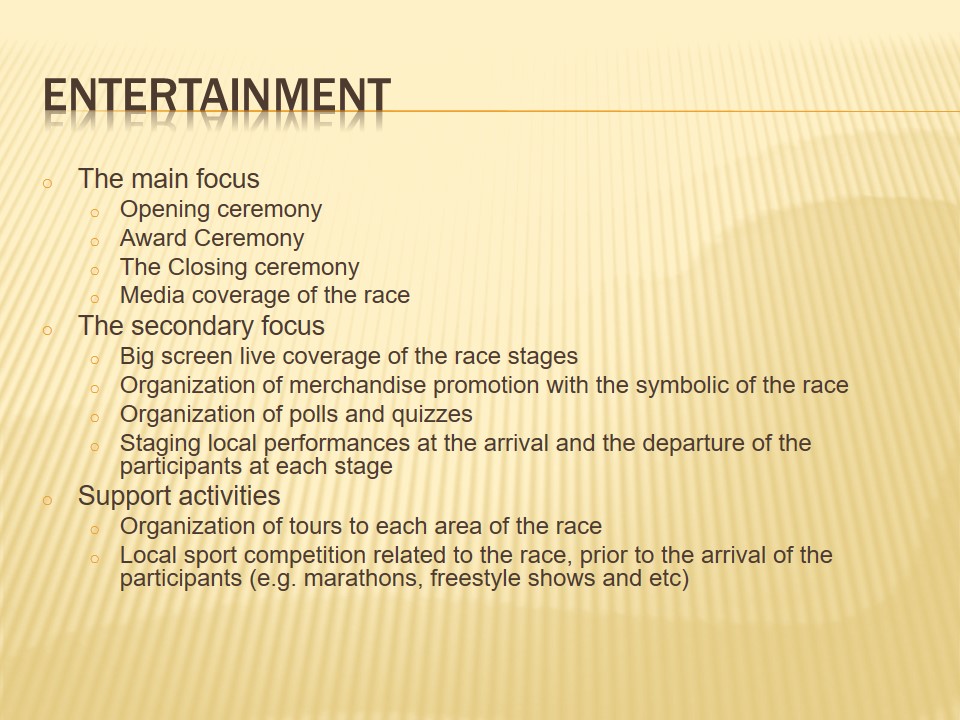
Environment
The environment factor implies the creation of an environment that transfers the theme of the event. The following factors can be taken as points of consideration for the even and its stages:
- The organization of the decoration for all the stages of the event, including the stage for performances, the flags, the boards, the promotional materials, banners and etc.
- The organization of the race symbolic, main musical theme and the setting of colors.
- The organization of cleaning procedures, including managing the waste disposal organization throughout the race, and the removal of the promotional material after the finishing of the events.

Food and Beverage
- The provision of food and beverage stands at each stage of the competition as well as sub-points of spectators gathering.
- The inclusion of promotional material with the food stands and the sponsorship symbolic and promotional materials.
- The organization of essential supplies for the participants of the race, throughout the race.
- Organizing the logistics of the delivery and disposal of food and beverages during the event.

Production
- The production of the printed materials for the events (brochures, guides, instructions and etc).
- The coordination of the interaction with the sponsors, for the promotion materials to be arranged and placed.
- Setting the audio visual arrangement where planned:
- The concerts (setting the stage, the lighting of the stage, organizing the sound equipment for the concert, setting the scene for the pyrotechnics);
- The race ( audio equipment for musical accompaniments, the screens and etc);
- Arranging the correspondence of the production with the theme of the event in terms of musical theme, colors and symbols.

Limitations
An important element to consider is the selection of the performers for the opening and closing ceremonies, where the performers should combine the transfer of the local culture as well as being recognizable by the mass public in the world.
The entertainment activities throughout the event should be complementary to the main focus of Tour de France, i.e. the competition, and should act as fillers in the pauses of the event rather than replacements.
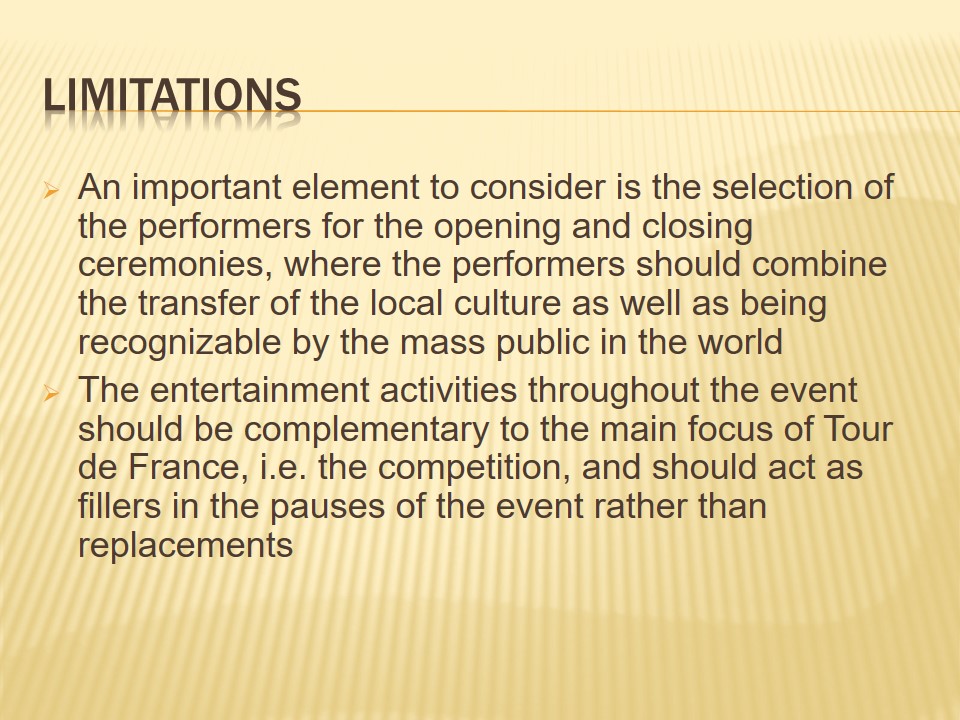
Conclusion
The main purposes of the events omitting its sport activity part, is creating a show that keeps the attention of the viewers to the sport as well as creating a magnificent popular celebration. In that regard, it can be seen that the design of the events are matching the established objectives of the event.
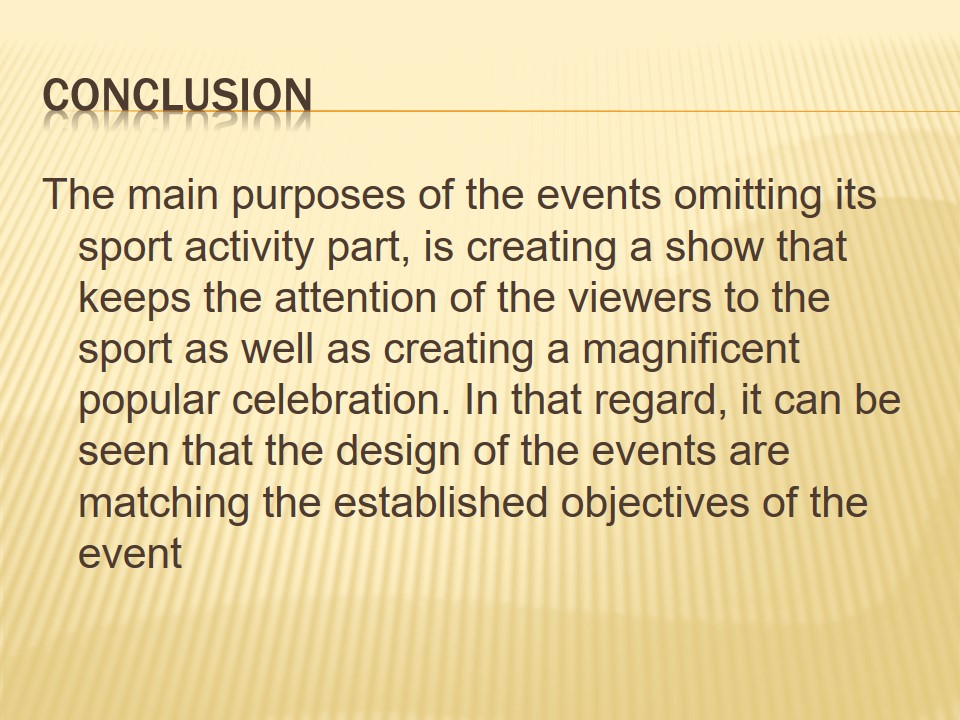
Further Discussion
The question that should be asked is to what extent the event’s supplementary activities can overlap its main focus, specifically for the spectators participating in the event. Taking into consideration the extension of the race and its duration, how the division between the activities should be arranged.
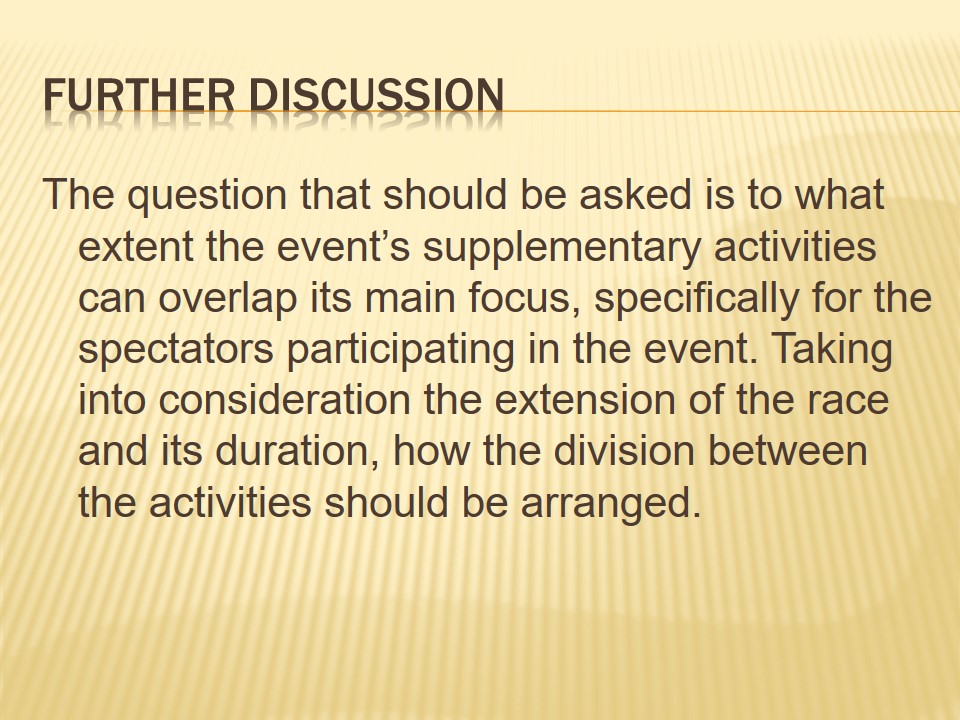
References
Berridge, G. (2007) Events design and experience, Oxford ; Burlington, MA, Butterworth-Heinemann.
Carr, K. (2006) Tour de France 2006 Route Map, List of Stages, Teams, Riders and Trivia. About. Web.
Dauncey, H. & Hare, G. (2003) The Tour de France, 1903-2003 : a century of sporting structures, meanings, and values, London ; Portland, OR, F. Cass.
(2009) Le Parcurs. Le Tour de France. Web.
Prudhomme, C. (2009) Editorial. Le Tour de France. Web.
(2009) Tour de France organisers unveil treacherous route for 2010. The Guardian. Web.